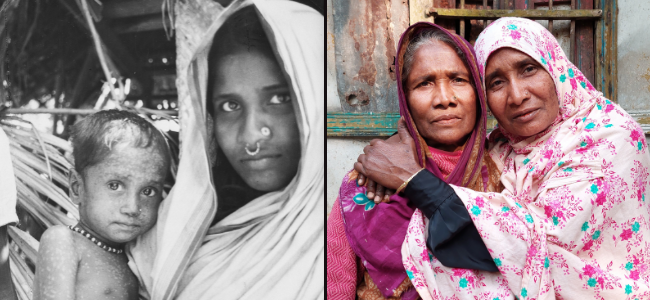*Translation support from Bengali to English provided by Dil Afrose Jahan
Joe Richman: From PRX’s Radiotopia, this is Radio Diaries. I’m Joe Richman.
More and more people are getting used to the idea that COVID-19 isn’t going to disappear anytime soon. Here’s Dr. Anthony Fauci at the World Economic Forum this past January.
Dr. Anthony Fauci: If you look at the history of infectious diseases, we’ve only eradicated one infectious disease in man and that’s smallpox. That’s not gonna happen with this virus.
Joe Richman: Our story today is about that one disease that has been eradicated: smallpox. Smallpox was around for thousands of years. Some of the earliest known evidence of the virus can be found on the mummified bodies of ancient Egyptian pharaohs. It was a horrible and visible disease.
Patients would develop painful sores all over their bodies. The most deadly form of smallpox, called Variola Major, killed almost a third of the people it infected. Survivors were often scarred for life. But thanks to the availability of the world’s very first vaccine, smallpox is eliminated in the U.S. by the mid-20th century.
And a few years later, the World Health Organization came together to try to stamp out the disease once and for all. Public health workers around the world traveled from country to country, tracking down cases by word of mouth and vaccinating entire villages where the virus was found. The last country to have cases of the deadly form of smallpox was Bangladesh.
And by the fall of 1975, public health workers there thought they were at the finish line. But off in a small remote village, a toddler was developing the telltale white spots. Today on the show, the story of that one last case.
Dil Afrose Jahan: What is your name?
Rahima Banu (Dil Afrose Jahan): My name is Rahima Banu. My name is Rahima Banu. Growing up my village was called South Kuralia. It was close to the river.
My house was made of cattail leaves. It had a mud floor. My father was a laborer. He caught fish and cut down trees with a saw. My mother was a housewife. I was their first child and I was adored. When I was one and a half years old, I had smallpox.
Daniel Tarantola: My name is Daniel Tarantola and back in 1975, I was a medical officer with WHO assigned to Bangladesh for the eradication of smallpox.
Alan Schnur: My name is Alan Schnur and I was a WHO epidemiologist in Bangladesh.
Daniel Tarantola: The smallpox eradication campaign had been an exhausting exercise. Long travels by boat and in Land Rovers and whatnot. And so we were celebrating the end of a very difficult road.
Alan Schnur: We were at a meeting in Dhaka at that time. They had a zero up on the wall saying these are the currently the number of active smallpox cases in Bangladesh.
Archival: Good morning.
Daniel Tarantola: And we had informed the press.
Archival: I understand that you have an official statement today with regard to Bangladesh.
Yes, indeed. Uh, as far as can be determined, we believe we have seen the last case of the deadliest form of smallpox, Variola Major.
Well, thank you very much, Dr. Henderson. I’d like to thank my colleagues here in New York.
Daniel Tarantola: Then we decided to celebrate and we organized a party. And as we were having the party, we received three telexes, two of them saying wonderful achievements, congratulations, and then a third message came from our team based in Bhola Island in the Bay of Bengal.
Give me a second because I can read the message. One active smallpox case. Date of detection, 14 November 75. Details follow. So this was a pretty dramatic setback.
Rahima Banu (Dil Afrose Jahan): My uncle got sick and I went up to him and jumped on him and started playing with these marks he had on his body. On that very night, my mother saw three pimples break out in my forehead. And by the morning, I had it all over my body.
Daniel Tarantola: Our whole was to go to the home where the case had been found and check that indeed, those facial scars and other scars on her body were being caused by smallpox.
Alan Schnur: There was some civil unrest at the time. So they had announced that all WHO international staff are restricted to Dhaka. We got into the Jeep and slouched down. I put some sort of cloth over my head, so people wouldn’t see that there was this international WHO staff breaking the regulations. We then got onto the launch. The next day we arrived in the morning. And took this very flimsy boat with no life rafts across this huge river. And then we had to walk up to the household where the smallpox case was.
Rahima Banu (Dil Afrose Jahan): My mother saw a lot of people coming towards us. It looked like the waiting celebration. It was so many people. So my mother picked me up so that they wouldn’t see me.
Daniel Tarantola: It was the end of the day. So it was fairly dark outside and there was a kerosene lantern inside their house, giving a little light.
We found a woman sitting there on a bed, bamboo bed, holding a child. The child she had white spots on the face, on the palms, on the souls, on the legs and arms. And she began to cry and I took a picture of her then crying and the mother holding her in her arms.
Rahima Banu (Dil Afrose Jahan): They have that photo of us. I was little and I was afraid of all the people. My mother was shocked. She couldn’t say a single word.
Daniel Tarantola: We explained to her what the procedure would be, that we would have to isolate the child in her home, that there would be guards around, that visitors would be limited, but would have to be vaccinated.
Rahima Banu (Dil Afrose Jahan): They set up three camps around our house and they paid our neighbors to watch us so that we wouldn’t try to run away. Everyone in that area made money from it.
Daniel Tarantola: And we can start on that side. The other one will start on the white side.
Alan Schnur: Then I said, okay, we need to organize containment now.
Archival: The best way to stop smallpox is to vaccinate.
Daniel Tarantola: We hired volunteers from the neighborhood to vaccinate everyone within a 1.5-mile radius of the house.
Archival: The vaccine comes in two vials and this is the vaccine here.
Daniel Tarantola: People would train over a couple of hours. We gave them needles. We had to mix the vaccine. Then dip your needle there.
Archival: You see you just hit the skin 15 times like this.
Rahima Banu (Dil Afrose Jahan): People in the village were afraid that they would die from the vaccine. Some didn’t want to take it out of fear.
Daniel Tarantola: For them to be confident that there was no risk in vaccinating people, we used to vaccinate ourselves. I must have vaccinated myself 10,000 times in Bangladesh during the time I was there. And usually, when there was enough time taken to listen to their concerns, the acceptance of vaccination is very high.
Archival: Okay. Is it clear now? Alright? We go vaccinate.
Alan Schnur: Off we went, house by house in the middle of the night to knock on doors.
I remember one house. It was a two-story house. And this guy, he opened the window and says, “Are you crazy? It’s two o’clock the morning. What are you doing here? Go away, go away.” So we continued knocking politely on the door saying, “Well, you know, we can’t leave until we vaccinate everyone.”
Daniel Tarantola: We realized over the following three weeks that there was another active case that is infectious case on the island.
Alan Schnur: We knew at the time that we were taking part in a, quite a historic event. When we started smallpox eradication, people said, you’re crazy. You can never eradicate smallpox. And then eventually we, of course, achieved smallpox eradication. And then people said, What took you so long?
Archival: Today, a substantial milestone in human history. The World Health Organization says smallpox has now been wiped off the face of the earth and will never return. It says it’ll never return because smallpox can only be caught from another person. And if no other person has it, there is no other way to catch it.
Daniel Tarantola: If we had to invent a disease in order to be able to eradicate it, we would have invented smallpox. It was such a visible disease.
Alan Schnur: You could see it. And that’s why COVID-19 is so difficult to control because you have people walking around with no symptoms, but spreading the disease. Even today, you’ve never seen a case of smallpox and that’s something one can take some pride in. I had some small hand in bringing that about.
I haven’t seen Rahima Banu since the time I was in Kuralia village, but I understand that she’s doing very well. And she has some fame as being the last, Variola Major smallpox case in the world.
Rahima Banu (Dil Afrose Jahan): I was named the last person to have smallpox. Allah kept me alive, but I still have scars from my disease.
It’s a dark, dark, dark spot all over my body. I don’t look beautiful with these scars. Sometimes people discriminate against me. If I wouldn’t have had this disease, honestly, I could have married off to a wealthy family. But I have a husband. He’s a day laborer. He didn’t see me before we married, but he accepted me. He likes me as I am.
I’m healthy. I have a family. I have children. My parents are alive. I have everything.
Joe Richman: In May of 1980, the World Health Organization officially declared that smallpox had been eradicated. The smallpox virus now exists in just two places, a lab in Russia and another in the United States. We’ll be back in a minute with the story of how we actually found Rahima Banu. That’s after this message.
It was almost a year ago that we first started looking into the story of Rahima Banu, the last person in the world to have the deadliest form of smallpox. Rahima’s case was well-documented. But finding her turned out to be surprisingly difficult. After hitting a lot of dead ends, we enlisted the help of a Bangladeshi journalist named Dil Afrose Jahan. She was the person who went to interview Rahima and whose voice you heard translating Rahima’s words. Our producer, Alissa Escarce, recently talked to Afros about that experience. Here’s Alissa.
Alissa Escarce: Okay so Afros, I reached out to you last fall to see if you could help me find Rahima. Could you talk a little bit about the road you went down to try to find her and some of the dead ends that you hit?
Dil Afrose Jahan: Yeah. I reached out to the local government authority, so they actually printed out the list of workers in Rahima’s village. Almost six and a half thousand people.
Alissa Escarce: That’s a lot.
Dil Afrose Jahan: Yeah, a lot. There I found around 60 Rahimas.
Alissa Escarce: 60 people named Rahima in her village?
Dil Afrose Jahan: Yeah, at least. Yeah. It’s a very common name. And then I tried to match the people born between 1965 to 1979, ’80. So I ended up with almost six Rahimas. I sent one of my friends who used to work in that area before. He went door to door.
Alissa Escarce: So he would go to their homes usually and then he would ask for Rahima and put you on the phone with them, was that how it worked?
Dil Afrose Jahan: Yes. And they’re like, no, we didn’t have any smallpox. None of them was Rahima… That we’re looking for, but people was asking him so many questions, like why some random man would look for a very ordinary housewife, who is at her fifties, you know, why? Why?
Alissa Escarce: So then eventually I was able to get in touch with the right person who had her phone number at the World Health Organization. And then you called. What is she like? What were your first impressions of her?
Dil Afrose Jahan: First I spoke to her daughter, not her.
Alissa Escarce: On the phone?
Dil Afrose Jahan: Yeah. I convinced her to pass the phone to her mother and then she wanted to see me in person. She invited me to her house. What she said was very interesting to me is, “If you don’t see me in person then how would you understand me?”
Alissa Escarce: Yeah. That’s kind of deep.
Dil Afrose Jahan: Yes, it is. It is.
Alissa Escarce: So tell me first about the place that Rahima is from. It seemed to me that, like, even within Bangladesh, that this area, Bhola Island, that Rahima is from, is considered pretty rural and pretty remote and hard to get to. Is that true?
Dil Afrose Jahan: Uh, yes. People are so vulnerable because the place is so remote. Mostly, they are farmers, they’re day laborers, they’re fishermen. This part of the country is prone to cyclone, flood. They do suffer from different climate disasters. So it’s a very difficult life.
Alissa Escarce: Yeah. So you went down, what was her home like?
Dil Afrose Jahan: I went inside her home and then she started serving me some food, some drinks. She’s tall. She covered her whole face with a hijab. It’s just her eyes, nose, lips, and some cheek are open and the rest was covered with hijab and she was also wearing full sleeve. So I could only see her hands and nothing else. Rahima is a very nice storyteller. I must say.
Alissa Escarce: You know, I don’t understand Bengali, but she’s very animated when she tells these stories from her childhood. And a lot of them are stories that she can’t remember herself because she was so young. But she tells them with a lot of, like she has strong emotions about these stories. But was that your impression when you were talking to her?
Dil Afrose Jahan: Um, she, she holds these stories her entire life. And she carries them with her body. Like whenever she sees herself in the mirror, then she can relay everything that her mother told her.
Alissa Escarce: Like seeing her scars probably reminds her of all these stories all the time. Did you get a sense of what she thinks about the fact that she’s kind of famous, even though she’s also a regular housewife, as you said?
Dil Afrose Jahan: She feels proud about her. She feels honored. And then again, she feels upset because people forget her. She mentioned it in the interview that she’s the last person of something that actually made the world suffer for hundreds of years. She thinks she could provide a lot to the world. For example, hope. She, and in her entire interview, she seems very hopeful that people have this natural instinct of survival.
Alissa Escarce: Yeah. I did notice with her scars, for example, like she talks about the ways that it made her life difficult, but it seems like she emphasizes more the ways that her life continued and was okay and was good.
Dil Afrose Jahan: Yeah. She accepted it and life moves on if you accept it. I saw a fighter, a survivor, you know, with a lot of emotions.
Joe Richman: Our story about Rahima Banu was produced by Alissa Escarce with reporting and translation by Dil Afrose Jahan. It was edited by Ben Shapiro and Deborah George and me. Additional translation help from Kasara Hassan. Special thanks to Leigh Henderson, who dug up reel-to-reel tapes of the 1975 press conference you heard in the story, which hadn’t been played in decades. And thanks to the GBH archive for their 1985 documentary, “The Last Wild Virus,” which included a scene you heard of Daniel Tarantola reenacting his work in Bangladesh. The Radio Diaries team is Alissa Escarce, Nellie Gilles, Mycah Hazel, Stephanie Rodriguez, and me, along with our editors, Ben Shapiro and Deborah George.
Radio Diaries is part of the Radiotopia network from PRX. We have support from the National Endowment for the Humanities, the New York City Department of Cultural Affairs. And from listeners like you. I’m Joe Richman. Thanks for listening.








